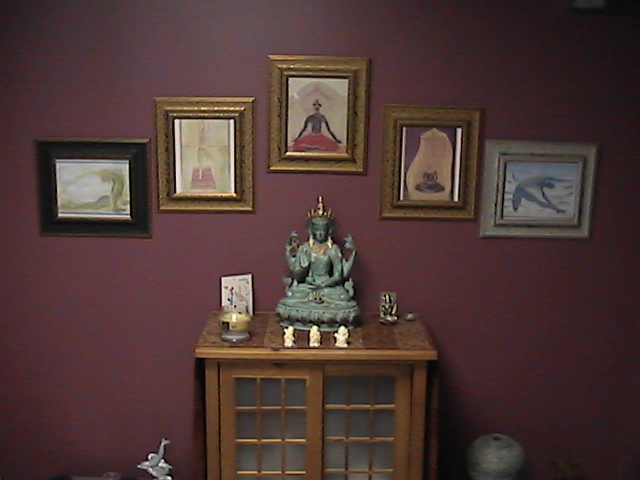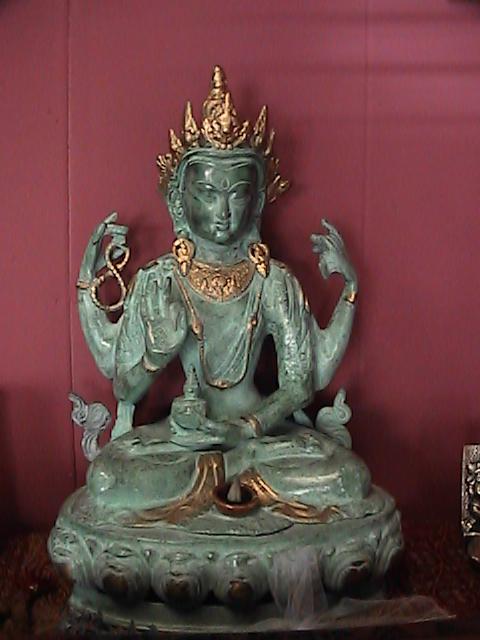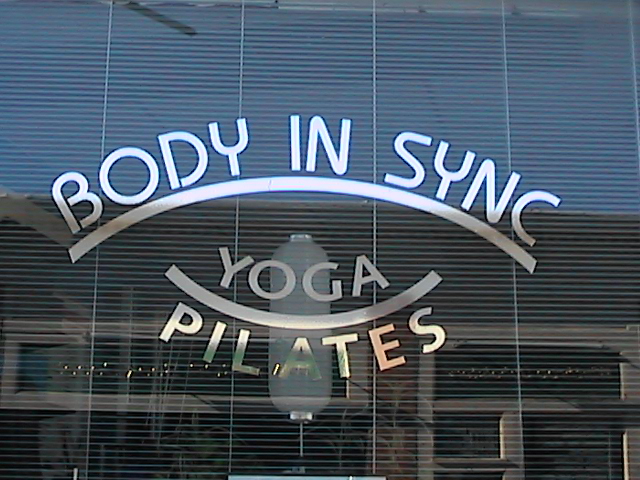Origins
Yoga was developed in ancient India
as far back as 5,000 years ago; sculptures detailing yoga positions have been
found in India which date back to 3000 B.C. Yoga is derived
from a Sanskrit word which means "union." The goal of classical yoga
is to bring self-transcendence, or enlightenment, through physical, mental and
spiritual health. Many people in the West mistakenly believe yoga to be a
religion, but its teachers point out that it is a system of living designed to
promote health, peace of mind, and deeper awareness of ourselves. There are
several branches of yoga, each of which is a different path and philosophy
toward self-improvement. Some of these paths include service to others,
pursuit of wisdom, non-violence, devotion to God, and observance of spiritual
rituals. Hatha yoga is the path which has physical health and balance as a
primary goal, for its practitioners believe that greater mental and spiritual
awareness can be brought about with a healthy and pure body.
The origins of Hatha yoga have been
traced back to the eleventh century A.D. The Sanskrit word ha
means "sun" and tha means "moon," and thus Hatha,
or literally sun-moon yoga, strives to balance opposing parts of the physical
body, the front and back, left and right, top and bottom. Some yoga masters (yogis)
claim that Hatha yoga was originally developed by enlightened teachers to help
people survive during the Age of Kali, or the spiritual dark ages, in which
Hindus believe we are now living.
The original philosophers of yoga
developed it as an eight-fold path to complete health. These eight steps
include moral and ethical considerations (such as honesty, non-aggression,
peacefulness, non-stealing, generosity, and sexual propriety), self-discipline
(including purity, simplicity, devotion to God, and self-knowledge), posture,
breath control, control of desires, concentration, meditation, and happiness.
According to yogis, if these steps are followed diligently, a person can reach
high levels of health and mental awareness.
As it has subsequently developed, Hatha
yoga has concentrated mainly on two of the eight paths, breathing and posture.
Yogis believe breathing to be the most important metabolic function; we
breathe roughly 23,000 times per day and use about 4,500 gallons of air, which
increases during exercise. Thus, breathing is extremely important to health,
and prana, or life-force, is found most abundantly in the air and in
the breath. If we are breathing incorrectly, we are hampering our potential
for optimal health. Pranayama, literally the "science of
breathing" or "control of life force," is the yogic practice of
breathing correctly and deeply.
In addition to breathing, Hatha yoga
utilizes asanas, or physical postures, to bring about flexibility, balance and
strength in the body. Each of these postures has a definite form and precise
steps for achieving the desired position and for exiting it. These postures,
yogis maintain, have been scientifically developed to increase circulation and
health in all parts of the body, from the muscular tissues to the glands and
internal organs. Yogis claim that although Hatha yoga can make the body as
strong and fit as any exercise program, its real benefits come about because
it is a system of maintenance and balance for the whole body.
Yoga was brought to America in the
late 1800s, when Swami Vivekananda, an Indian yogi, presented a lecture on
yoga in Chicago. Hatha yoga captured the imagination of the Western mind,
because accomplished yogis could demonstrate incredible levels of fitness,
flexibility, and control over their bodies and metabolism. Yoga has flourished
in the West. Americans have brought to yoga their energy and zest for
innovation, which troubles some Indian yogis and encourages others, as new
variations and schools of yoga have developed. For instance, power yoga is a
recent Americanized version of yoga which takes Hatha yoga principles and
speeds them up into an extremely rigorous aerobic workout, and many strict Hatha
yoga teachers oppose this sort of change to their philosophy. Other variations
of Hatha yoga in America now include Iyengar, Ashtanga, Kripalu, Integral,
Viniyoga, Hidden Language, and Bikram yoga, to name a few. Sivananda yoga was
practiced by Lilias Folen, who was responsible for introducing many Americans
to yoga through public television.
Iyengar yoga was developed by B.K.S.
Iyengar, who is widely accepted as one of the great living yogis. Iyengar uses
classical Hatha yoga asanas and breathing techniques, but emphasizes great
precision and strict form in the poses, and uses many variations on a few
postures. Iyengar allows the use of props such as belts, ropes, chairs, and
blocks to enable students to get into postures they otherwise couldn't. In
this respect, Iyengar yoga is good for physical therapy because it assists in
the manipulation of inflexible or injured areas.
Ashtanga yoga, made popular by yogi
K. Patabhi Jois, also uses Hatha yoga asanas, but places an emphasis on the
sequences in which these postures are performed. Ashtanga routines often
unfold like long dances with many positions done quickly one after the other.
Ashtanga is thus a rigorous form of Hatha yoga, and sometimes can resemble a
difficult aerobic workout. Ashtanga teachers claim that this form of yoga uses
body heat, sweating, and deep breathing to purify the body.
Kripalu yoga uses Hatha yoga
positions but emphasizes the mental and emotional components of each asana.
Its teachers believe that tension and long-held emotional problems can be
released from the body by a deep and meditative approach to the yoga
positions. Integral yoga seeks to combine all the paths of yoga, and is
generally more meditative than physical, emphasizing spirituality and
awareness in everyday life. Viniyoga tries to adapt Hatha yoga techniques to
each individual body and medical problem. Hidden Language yoga was developed
by Swami Sivananda Radha, a Western man influenced by Jungian psychology. It
emphasizes the symbolic and psychological parts of yoga postures and
techniques. Its students are encouraged to write journals and participate in
group discussions as part of their practice. Bikram yoga has become very
popular in the late 1990s, as its popular teacher, Bikram Choudury, began
teaching in Beverly Hills and has been endorsed by many famous celebrities.
Bikram yoga uses the repetition of 26 specific poses and two breathing
techniques to stretch and tone the whole body.
A Hatha yoga routine consists of a
series of physical postures and breathing techniques. Routines can take
anywhere from 20 minutes to two hours, depending on the needs and ability of
the practitioner. Yoga should always be adapted to one's state of health; that
is, a shorter and easier routine should be used when a person is fatigued.
Yoga is ideally practiced at the same time every day, to encourage the
discipline of the practice. It can be done at any time of day; some prefer it
in the morning as a wake-up routine, while others like to wind down and
de-stress with yoga at the end of the day.
Yoga asanas consist of three basic
movements: backward bends, forward bends, and twisting movements. These
postures are always balanced; a back bend should be followed with a forward
bend, and a leftward movement should be followed by one to the right.
Diaphragm breathing is important during the poses, where the breath begins at
the bottom of the lungs. The stomach should move outward with the inhalation
and relax inward during exhalation. The breath should be through the nose at
all times during Hatha asanas. Typically, one inhales during backward bends
and exhales during forward bending movements.
The mental component in yoga is as
important as the physical movements. Yoga is not a competitive sport, but a
means to self-awareness and self-improvement. An attitude of attention, care,
and non-criticism is important; limitations should be acknowledged and calmly
improved. Patience is important, and yoga stretches should be slow and worked
up to gradually. The body should be worked with, and never against, and a
person should never overexert. A yoga stretch should be done only so far as
proper form and alignment of the whole body can be maintained. Some yoga
stretches can be uncomfortable for beginners, and part of yoga is learning to
distinguish between sensations that are beneficial and those that can signal
potential injury. A good rule is that positions should be stopped when there
is sharp pain in the joints, muscles, or tendons.

Preparations
All that is needed to perform Hatha
yoga is a flat floor and adequate space for stretching out. A well-ventilated
space is preferable, for facilitating proper breathing technique. Yoga mats
are available which provide non-slip surfaces for standing poses. Loose,
comfortable clothing should be worn. Yoga should be done on an empty stomach;
a general rule is to wait three hours after a meal.
Yoga is an exercise that can be done
anywhere and requires no special equipment. Yoga uses only gravity and the
body itself as resistance, so it is a low-impact activity excellent for those
who don't do well with other types of exercise. The mental component of yoga
can appeal to those who get bored easily with exercise. By the same token,
yoga can be a good stress management tool for those who prefer movement to
sitting meditation.

Precautions
As with any exercise program, people
should check with their doctors before starting yoga practice for the first
time. Those with medical conditions, injuries or spinal problems should find a
yoga teacher familiar with their conditions before beginning yoga. Pregnant
women, particularly after the third month of pregnancy, should only perform a
few yoga positions with the supervision of an experienced teacher. Some yoga
asanas can be very difficult, and potentially injurious, for beginners, so
teachers should always be consulted as preparation for advanced yoga
positions. Certain yoga positions should not be performed by those with
fevers, or during menstruation.
Side effects
Those just beginning Hatha yoga
programs often report fatigue and soreness throughout the body, as yoga
stretches and exercises muscles and tendons which are often long-neglected.
Some yogic breathing and meditation techniques can be difficult for beginners
and can cause dizziness or disorientation; these are best performed under the
guidance of a teacher.

